|
Oman
| General | Travel
| Visas | Locations | Maps,
books | Geology | Snapshots
Bandar Khayran | Jabal
Akhdar | Masirah | Mountains
| Musandam | Salalah | Seifa
| Wadi Mistal | Wahibah
The Green Mountain
Al Jabal al Akhdar lies at the heart of Al Hajar,
the mountains of northern Oman (see satellite image). The image
will open in a separate window. The size is 72.5K and the file takes
up to 30 seconds to download fully at 28.8Kbps.
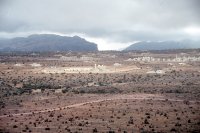 |
New buildings in Saiq, which lies
at the highest altitude of the towns of Oman. The town stretches
over an extensive plateau at the summit of Al Jabal al Akhdar, where the
mountains reach heights of 3,000 m or more. |
Structurally, Al Jabal al Akhdar is a huge anticline
flanked by hard limestones of Jurassic to Cretaceous age and ophiolites,
enthrusted mantle rocks. The core of the anticline has been eroded
to reveal older rocks dating back through the Permian to the early Precambrian.
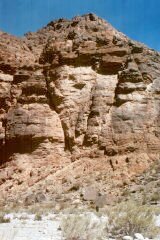 |
|
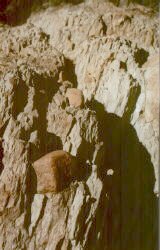 |
| Angular
unconformity between tilted Palaeozoic rocks and overlying Permian limestones.
The time gap between deposition of the the two series is estimated at 300
million years. Wadi bani Kharus. |
|
Tillite,
an ancient boulder clay deposited perhaps 600 million years ago when Oman
lay in a cold climate zone. Wadi bani Kharus. |
Night temperatures can drop below zero centigrade
in winter from November until March, and snow is not unknown. Conversely,
the climate is very pleasant in the height of summer and the jabal is a
welcome retreat for campers with four wheel drive vehicles.
 |
|
 |
| Ladies
meet at a government installed cistern in Saiq to collect water and exchange
gossip. Bit cold in December. |
|
Village
clings to the hillside under lowering cloud in winter. |
Several major wadis drain Al Jabal al Akhdar: Wadis
bani Awf, Sahtan and bani Kharus north to Al Batinah, and Wadi Ghul to
the south.
 |
|
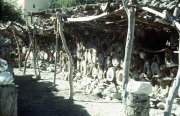 |
| A view
of Wadi bani Awf. |
|
Bee-keeping
in Wadi Sahtan. The hives are hollowed out date palms. |
The way of life remains traditional with scattered
communities growing date palms and fodder crops fed by groundwater and
springs.
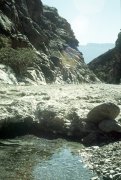 |
|
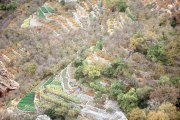 |
| Groundwater
seeps from alluvial gravel in Wadi Sahtan. |
|
The hill
farmers have long used terracing to conserve their precious resources of
soil and water. Agriculture here is spring-fed. |
In the more sheltered areas, a variety of tree crops
are grown, such as almonds, walnuts, apricots, peaches, figs and pomegranates.
Pomegranates are prized. The best specimens can fetch as much as
$15 for ten pieces in local souqs (markets).
 |
|
 |
| A small-holding
seen through the bare branches of an orchard in winter. A few pomegranates
still hang from the trees. |
|
Prize
pomegranates. |
| Other major occupations are perfume-making
from flowers and weaving. Sheeps' wool is used to make colourful
rugs costing between $15 to $60, if you know how to bargain. The
prices will be much more in shops in the capital. Note the sheep-skin
water container hanging in the top left-hand corner of the picture. |
 |
Physical conditions of life may be hard on Al Jabal
al Akhdar, but traditions of culture and hospitality endure and thrive.
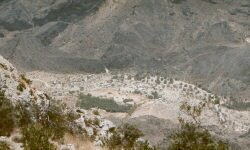 |
|
 |
| A village
nestling in the valley below Sharfat al Alamayn, the viewpoint over Al
Jabal al Akhdar. |
|
Children on Jabal Shams |
The Al
Jabal Al-Akhdhar Hotel is now open to guests, lying on the road to
Saiq amongst the villages of the plateau. Access is from Birkat al Mauz
on the road to Nizwa. You used to need permission from the military to ascend to
the plateau, but Reinhard Siegl ofOman Trekking tells me that this is no longer necessary. However, you will not be allowed to ascend the mountain unless you have a four-wheel drive vehicle to tackle the steep,
winding road. The hotel management can probably advise on this for you.
Phone: +968 25429009 Fax: +968 25429119
Back to more pages on Off-road in Oman
Contact me This page designed for 640 x 480 pixel display
Home |
Contact me | Resume |
George |
Oman |
Cyprus | Thailand
|














